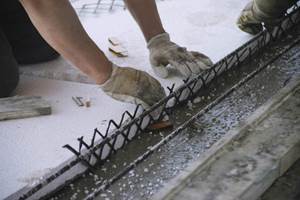Huntsman, Acciona collaborate on all-composite lighthouse
The first-ever all-composite lighthouse is now installed at the port of Valencia in Spain.
Huntsman Advanced Materials, The Woodlands, Texas, and Acciona, Madrid, Spain, worked together to create an all-composite lighthouse through a combination of new material systems and processes. Whereas concrete builds typically take 28 days to be fully cured and an additional 21 to install, the all-composite lighthouse was completed in less than 20 days – six hours of which involved its installation, using a lightweight crane due to its advantageous size-to-weight ratio.
The lighthouse project focused on short and efficient manufacturing cycle times of CFRP and GFRP composites. This was achieved using innovative materials, form factors and processing technologies. Here’s a look at how it all came together.
Developed as a first prototype by Acciona at the beginning of January 2013, this tower structure is testament to the advances in materials engineering that occurred in the short time the project took to complete in February 2015. For example, following the design and process selection, all the composite components were manufactured within a month at Acciona’s composite workshop in Madrid.
Combinations of hybrid, CFRP and GFRP composites were selected for the tower’s principal components to fulfil the design engineer’s vision for the 35m tall tower structure. To construct the tower’s structural column - made of eight 35m long CFRP pultruded tubes with an outside diameter of 250mm and 20mm thickness - Acciona developed a special pultrusion process that produced high quality, very thick pultruded profiles combining carbon tows and heavy carbon fabrics.
The epoxy-compatible glass fiber supplied by Owens Corning, Midland, Mich, for the GFRP tubes was specified for its ease of impregnation, faster pulling speed and better chemical resistance.
Architectural requirements stipulated that while the lightweight GFRP floors were subject to certain aesthetics and chemical resistance factors, they should also not exceed 20cm thickness.
Due to the constraints of cost, time, dimensional tolerance surface finish and ease of molding, Acciona decided to develop a resin infusion process to create the floors. As manufacturing needed to be fast, a resin system with low viscosity, long pot life and low exotherm, which could also meet the necessary chemical and mechanical properties, was developed by Huntsman.
The project also required the production of slip-free, light weight (<25Kg), chemically and mechanically resistant, GFRP stairs that would not exceed 20cm thickness. Composites made by resin transfer molding (RTM), using resin from Huntsman, were identified as providing the optimal solution.
To join the pultruded CFRP and GFRP tubes, and in order to achieve the low weight, low maintenance, smooth surface, chemical resistance and aesthetics required, the use of metal fasteners were ruled out and a new system was designed that could also meet the complex structural, geometric and budgetary requirements. As part of this new system, carbon and glass fiber stiffeners were designed and produced using a user-friendly and low exotherm resin developed by Huntsman.
Acciona also selected ARALDITE adhesives to bond the lighthouse’s composite components together, chosen in preference to mechanical fastenings, which would detract from the look and add unnecessary weight to the final structure.
Combining a long pot life with fast curing, and thixotropic properties that facilitated easy application on the tower’s vertical surfaces, the ARALDITE epoxy based structural adhesive specified for this project delivered significant cost and production time savings. It also added to the strength of the composite structure, contributing to its lightweight and aesthetic appeal.
Before the lighthouse was commissioned, final tests were conducted to ensure it met load and wind requirements.
The technologies developed and proven for the lighthouse project are currently under consideration in numerous other projects including towers for wind energy, columns for bridges and mobile antennas.
Related Content
Fiberglass conduit manufacturer grows into new products, infrastructure applications
Texas-based Champion Fiberglass, a five-time CW Top Shops honoree, expands its success in the fiberglass composite conduit market into new applications and products, looking toward future automation and sustainability initiatives.
Read MoreSwedish parking garage to incorporate decommissioned wind blades
Architect Jonas Lloyd is working with Vattenfall to design the multistory building with a wind blade façade, targeting eco-friendly buildings and creative ways to remove blades from landfills.
Read MoreNorco GFRP molds meet high-quality cast concrete beam production needs
A project with P&M successfully achieved manufacture of six 20-meter-long architectural beams for an R&D facility with near-seamless surfaces and on a tight production schedule.
Read MoreComposites-reinforced concrete for sustainable data center construction
Metromont’s C-GRID-reinforced insulated precast concrete’s high strength, durability, light weight and ease of installation improve data center performance, construction time and sustainability.
Read MoreRead Next
Plant tour: Daher Shap’in TechCenter and composites production plant, Saint-Aignan-de-Grandlieu, France
Co-located R&D and production advance OOA thermosets, thermoplastics, welding, recycling and digital technologies for faster processing and certification of lighter, more sustainable composites.
Read MoreVIDEO: High-volume processing for fiberglass components
Cannon Ergos, a company specializing in high-ton presses and equipment for composites fabrication and plastics processing, displayed automotive and industrial components at CAMX 2024.
Read MoreDeveloping bonded composite repair for ships, offshore units
Bureau Veritas and industry partners issue guidelines and pave the way for certification via StrengthBond Offshore project.
Read More
























